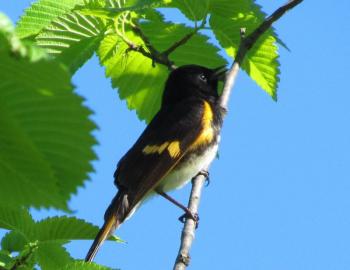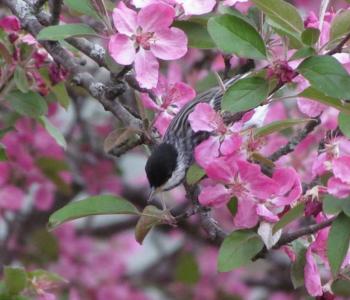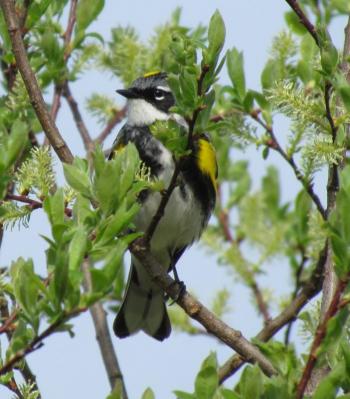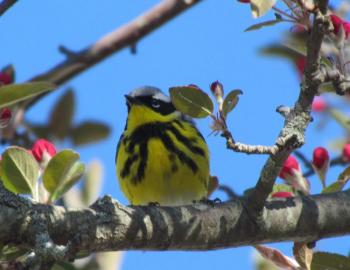Greedy for Warblers
We can’t help but be feeling a little greedy this spring.
Greedy for warblers, that is.
This spring in particular it seems like there have been multiple locations and dates that have yielded huge numbers of bright, breeding-plumaged warblers. A few weeks ago, we wrote about the first wave of yellow-rumped warblers and pine warblers that were coming into suet feeders in backyards across the state. We were fortunate not only to have some in our own yard but we got to see these and the all-red summer tanager — a Maine rarity — in a friend’s yard in East Boothbay.
After that came even more warblers. Right in our own backyard we had tiny blue and yellow northern parula warblers, zebra striped black-and-white warblers, and yellow warblers—bright yellow with red breast streaks. With each passing day we and dozens of other birders across the state began reporting trees practically dripping with the bountiful birding riches of warblers. Black-throated greens, their yellow cheeks blazing, sang their cheerful, buzzy “zee-zee-zee-zoo-zee” from the newly leafed-out maples. Black “robber masks” contrasting against their yellow underparts, just-arrived common yellowthroats skulked in the brush. Sporty little American redstarts flashed the bright orange patches in their jet black tails and wings.
Some birders found incredible concentrations at specific spots, reporting 50 or more individuals of some warbler species in a single morning. The numbers and diversity was a product of our up-and-down weather. The short duration warm-and-calm days would be followed by periods of cold and rain. Migrant birds would arrive here in Maine only to find themselves waiting for the next good opportunity for continuing their travels. Birds would build up in certain spots that had more insects, pollen, and maybe a little nectar. Such spots are often near water and in locations with a rich array of flowering and newly leafing-out trees.
The Boothbay Region Land Trust’s Lobster Cove Meadow is one of those spots. A birding friend reported 46 species of birds including 13 different kinds of warblers on a field trip there on May 11. A newly official nature trail called the Harrison Avenue Trail (yes, it is right off Harrison Avenue, if you are trying to find it) in Gardiner became one of the best go-to birding hotspots a little later in May. Here, for a week or more in May, birders reveled in watching an astounding abundance of migrant warblers at close range, including many that can be hard to find in migration. Flame orange-throated blackburnian warblers, red-cheeked male Cape May warblers, brick-red sided bay-breasted warblers, vibrantly contrasting yellow-black-and-gray magnolias, black-capped blackpolls, bright yellow-breasted and bluish-backed Canada warblers—all these and more were like a feast to the eyes.
As May progresses we began to feel like we are gorging on the sights and sounds of all of these shockingly beautiful and extravagant warblers. And yet we want more. At every opportunity we squeeze in another trip to look for them or even a quick run out to the backyard between household duties.
Yet, soon they will be gone from here as they continue on to their breeding grounds, perhaps here in Maine, perhaps up into the vast Boreal Forest of Canada.
Such is the dilemma of birding in spring. We are greedy for warblers, for we know that spring migration is a burst of life that engulfs us only once each year. We will rejoice in it—letting the warblers overflow our senses just as spring bursts upon the senses of all living things.
Jeffrey V. Wells, Ph.D., is a Fellow of the Cornell Lab of Ornithology. Dr. Wells is one of the nation's leading bird experts and conservation biologists and author of “Birder’s Conservation Handbook”. His grandfather, the late John Chase, was a columnist for the Boothbay Register for many years. Allison Childs Wells, formerly of the Cornell Lab of Ornithology, is a senior director at the Natural Resources Council of Maine, a nonprofit membership organization working statewide to protect the nature of Maine. Both are widely published natural history writers and are the authors of the book, “Maine’s Favorite Birds” and “Birds of Aruba, Bonaire, and Curaçao: A Site and Field Guide” from Cornell Press.






























